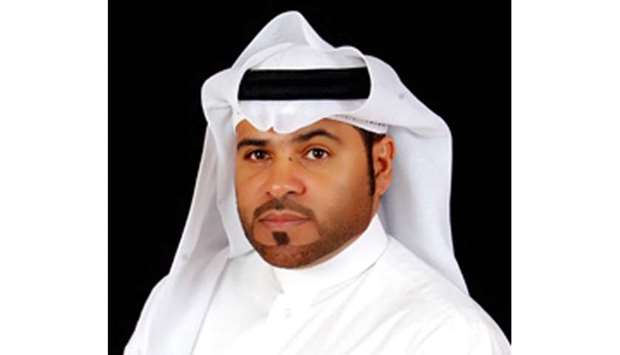“I believe in change. I believe that for an artist to grow, for him to be able to introduce new ideas and design concepts, he must continuously adapt to change. I also have a fascination for recycling old and used materials and transforming them into something fresh and new.”
Qatari artist Mohammed al-Atiq’s artistic traits are painting and collage on fabric with different sizes and dimensions. He uses different techniques. The artist uses abandoned ores such as locks, hair clips, nails, threads, fabric, used matchsticks, papers etc. He tries hard to use what he called “the little” to change its concept from its concrete status to the visual concept which would embed intellectual connotations.
Atiq is seeking to realise the aesthetic basics which would build bridges between him and the audience through the creation of a visual balance between the elements of the work of art which are the colours, the shapes and materials to serve his ideas. Community recently had an e-mail interview with the experienced and talented artist.
Please share your journey thus far with us briefly.
I was born in 1966 in Qatar. I have served as chairman of Qatar Fine Arts Society (2006-2012), graphic designer with Qatar TV in 1986, General Coordinator with Symposium Al Diar 2008-Qatar, and General Coordinator of the Al Asmakh International Art Symposium (2013-2014 and again 2015-2017).
I have also won many prizes including: The arbitration award in the first Biennial, Dhaka 2003; the arbitration award in the first Biennial, Dhaka 2008; second prize in the competition of National Heritage and the Environment in the Eyes of the Fine Artists 1998; jury prize competition Heritage and Environment of Country in the Eyes of Fine Artists 1999; first prize in the competition festival time the first day Sea to the Gulf Cooperation Council Jeddah; and first prize bronze statue in the second exhibition for the youth of the Gulf Cooperation Council.
How and when did you develop interest in art?
My passion for art began in childhood when I was impressed by the surrounding nature. I was inspired by the components of traditional heritage and folklore features. I tended to use those details collected in memory in my artworks through my very own style, to form my own aesthetic basics.
What kind of work and mediums do you use for your creative pieces? Tell us about some of the exhibitions you have attended as an artist so far.
My work can be described as a visual board that highlights the uniqueness of the little things which could be — from my own point of view — rebuild, reinstalled and reorganised.
I try through creativity and authenticity to pass beyond the visionary to comprehension so I could use simple elements, ordinary tools and even cheap material to create a distinguished artwork by finding alternative concept of time and place as well as building unusual connection between the work and the audience.
I have successfully managed to travel to a globally artistic space through presenting binaries of opposition like black-white which is an example of the whole components.
Tell us about your participation in the recent art project carried out by the Unesco.
I received an invitation from the Mediterranean Organization (MIDOS) in co-operation with Unesco to attend an exhibition of creativity through the idea of the mask, which has become a distinctive emblem during Covid-19 pandemic, and as a matter of support to everyone who protected, guided and watched over our comfort by offering something simple to those of our feelings. The exhibition highlighted the artistic works covering the shape of the solid mask with beautiful shapes and colours; recording, documenting and sharing the world artists’ views. The pandemic is affecting everyone and I hope Allah will soon put an end to the ailment, allowing the world to return to contentment and peace.
With all your experience how do you best describe art?
I believe in change. I believe that for an artist to grow, for him to be able to introduce new ideas and design concepts, he must continuously adapt to change. I also have a fascination for recycling old and used materials and transforming them into something fresh and new. There is always something unique and meaningful with anything, in everything around us. We just have to strive harder to see them.
As you know, art has its own place in the world. It is a kind of destination of every country and reflects the culture of every society and its history.
I had the experience of artistic residence in New York, and it was a unique experience, under the patronage of Qatar Museums, with a personal exhibition planned for the end of this year.
How have you been spending your time at home? Do you think having free time and being at home helps people increase their creativity?
It is not a strange thing for an artist to be at home. But the pandemic has created an opportunity for artistic minds to create more. They have time to discover new art technologies or get enrolled in new art schools.
How do you see the works of young artists? What advice will you share with them?
Young people should be aware and weary of the banal and cheap art that can be seen more often than not. They should focus on the art of an intellectual nature more because it presents new philosophies and helps in keeping pace with evolving thoughts on the art scene.
What are your plans for your artworks?
I had to postpone many due to the pandemic and resultant lockdown. I will have a personal exhibition sponsored by Fire Station and a group participation sponsored by Al Markhiya Gallery soon.

I have successfully managed to travel to a globally artistic space through presenting binaries of opposition like black-white which is an example of the whole components u2014 Mohammed al-Atiq


